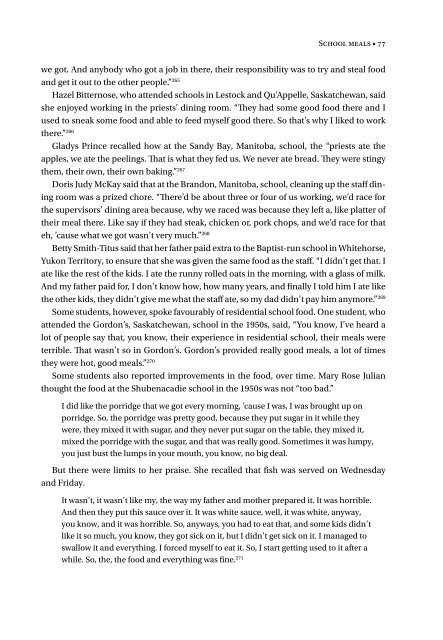The Survivors Speak
1MB8J05
1MB8J05
Create successful ePaper yourself
Turn your PDF publications into a flip-book with our unique Google optimized e-Paper software.
School meals • 77<br />
we got. And anybody who got a job in there, their responsibility was to try and steal food<br />
and get it out to the other people.” 265<br />
Hazel Bitternose, who attended schools in Lestock and Qu’Appelle, Saskatchewan, said<br />
she enjoyed working in the priests’ dining room. “<strong>The</strong>y had some good food there and I<br />
used to sneak some food and able to feed myself good there. So that’s why I liked to work<br />
there.” 266<br />
Gladys Prince recalled how at the Sandy Bay, Manitoba, school, the “priests ate the<br />
apples, we ate the peelings. That is what they fed us. We never ate bread. <strong>The</strong>y were stingy<br />
them, their own, their own baking.” 267<br />
Doris Judy McKay said that at the Brandon, Manitoba, school, cleaning up the staff dining<br />
room was a prized chore. “<strong>The</strong>re’d be about three or four of us working, we’d race for<br />
the supervisors’ dining area because, why we raced was because they left a, like platter of<br />
their meal there. Like say if they had steak, chicken or, pork chops, and we’d race for that<br />
eh, ’cause what we got wasn’t very much.” 268<br />
Betty Smith-Titus said that her father paid extra to the Baptist-run school in Whitehorse,<br />
Yukon Territory, to ensure that she was given the same food as the staff. “I didn’t get that. I<br />
ate like the rest of the kids. I ate the runny rolled oats in the morning, with a glass of milk.<br />
And my father paid for, I don’t know how, how many years, and finally I told him I ate like<br />
the other kids, they didn’t give me what the staff ate, so my dad didn’t pay him anymore.” 269<br />
Some students, however, spoke favourably of residential school food. One student, who<br />
attended the Gordon’s, Saskatchewan, school in the 1950s, said, “You know, I’ve heard a<br />
lot of people say that, you know, their experience in residential school, their meals were<br />
terrible. That wasn’t so in Gordon’s. Gordon’s provided really good meals, a lot of times<br />
they were hot, good meals.” 270<br />
Some students also reported improvements in the food, over time. Mary Rose Julian<br />
thought the food at the Shubenacadie school in the 1950s was not “too bad.”<br />
I did like the porridge that we got every morning, ’cause I was, I was brought up on<br />
porridge. So, the porridge was pretty good, because they put sugar in it while they<br />
were, they mixed it with sugar, and they never put sugar on the table, they mixed it,<br />
mixed the porridge with the sugar, and that was really good. Sometimes it was lumpy,<br />
you just bust the lumps in your mouth, you know, no big deal.<br />
But there were limits to her praise. She recalled that fish was served on Wednesday<br />
and Friday.<br />
It wasn’t, it wasn’t like my, the way my father and mother prepared it. It was horrible.<br />
And then they put this sauce over it. It was white sauce, well, it was white, anyway,<br />
you know, and it was horrible. So, anyways, you had to eat that, and some kids didn’t<br />
like it so much, you know, they got sick on it, but I didn’t get sick on it. I managed to<br />
swallow it and everything. I forced myself to eat it. So, I start getting used to it after a<br />
while. So, the, the food and everything was fine. 271


